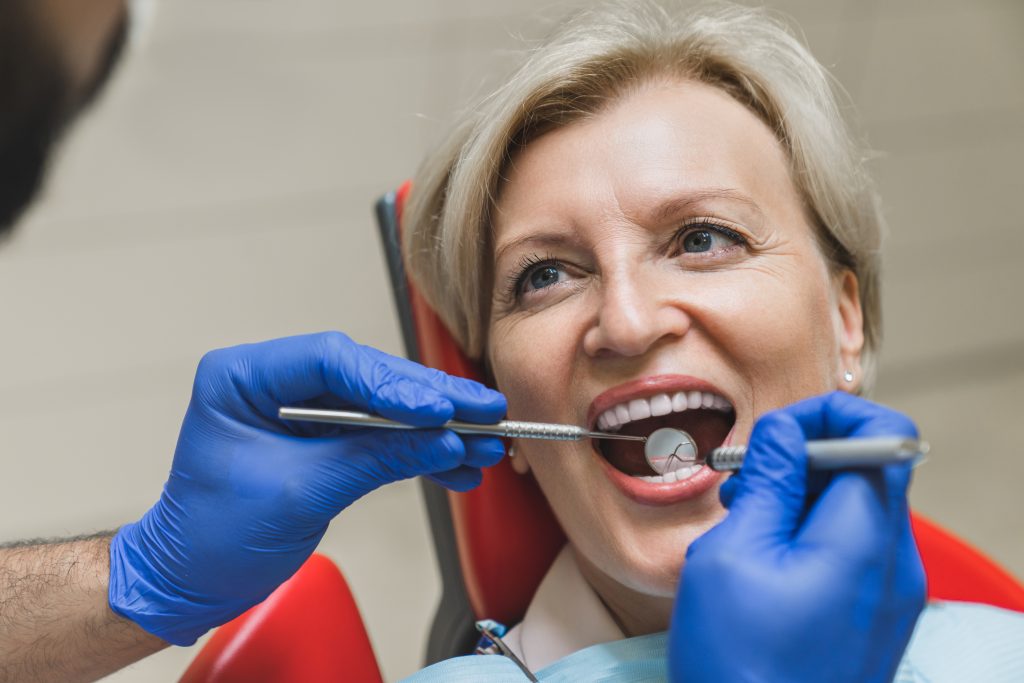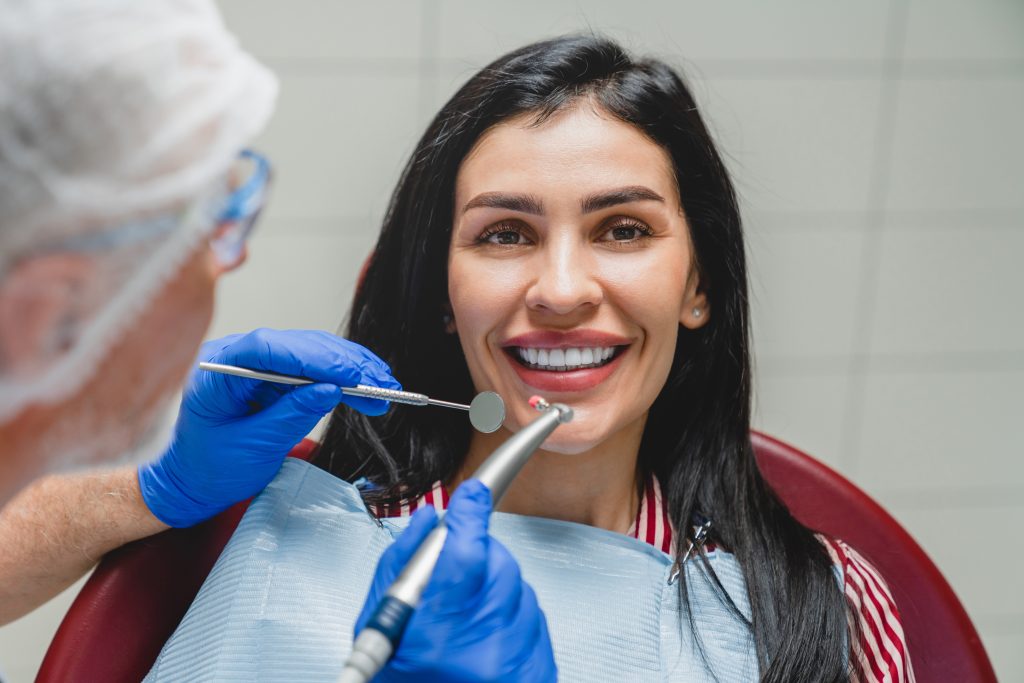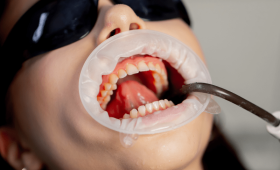What is Composite Bonding and What is its Purpose?
Composite bonding is a dental procedure used to aesthetically improve the appearance of teeth. In this method, a special material called composite resin, which matches the natural tooth color, is applied layer by layer to the tooth’s surface.
This resin is meticulously shaped by the dentist and then hardened with a powerful light. The procedure is used to cover small cracks, chips, discoloration, gaps between teeth, and to correct minor shape irregularities. As a result, an aesthetic and natural-looking smile is achieved with a minimally invasive method.
Who Can Get Composite Bonding?
Composite bonding is a suitable option for individuals with minimal to moderate aesthetic dental problems. People with small chips, cracks, gaps, slight discoloration, or shape irregularities in their teeth can benefit from this procedure.
It is often preferred when a minimal intervention to the teeth is desired, especially when the tooth enamel is healthy. It is an ideal solution for patients who are in good general oral and dental health and who do not have risk factors like smoking.
How Long Does the Composite Bonding Procedure Take?
The duration of the composite bonding procedure varies depending on the number of teeth to be treated and the complexity of the procedure. Generally, the procedure for a single tooth takes approximately 30 to 60 minutes.
If multiple teeth are to be bonded, the total time can extend up to several hours, depending on the dentist’s experience and the details of the case. One of its biggest advantages is that all aesthetic adjustments can usually be completed in a single dental visit.
Is There Any Pain During the Procedure?
The composite bonding procedure is generally a painless process and anesthesia is often not required. Since very little or no grinding is done on the tooth’s surface, there is no feeling of discomfort. Patients can sit comfortably while the dentist applies and shapes the composite material. No permanent pain or sensitivity is expected after the procedure either.
How Does the Bonding Material Match My Tooth Color?
Composite bonding material is produced in many different shades to perfectly match the natural color of your teeth. Before starting the treatment, your dentist will carefully analyze the current color of your teeth and select the most suitable shade. After the resin is applied to the tooth surface, it is artistically shaped and polished by the dentist to mimic the natural tooth tissue.
How Should I Care for My Teeth After Composite Bonding?
Caring for teeth after composite bonding is almost the same as caring for natural teeth. You should brush your teeth at least twice a day and use dental floss. It should be remembered that composite material is more prone to staining, so the consumption of coloring agents like coffee, tea, and red wine should be limited. Avoiding very hard foods also prevents the material from chipping.
What is the Lifespan of Composite Bonding?
The lifespan of composite bonding varies from person to person, but on average, it can last between 5 and 7 years. The durability of the material depends on factors such as oral hygiene, dietary habits, and whether the patient grinds their teeth. The material can slightly wear down or change color over time. In this case, the bonding material can be easily renewed or minor adjustments can be made, which is an advantage in the long run.
Is Composite Bonding a Reversible Procedure?
Yes, one of the most important advantages of composite bonding is that it is completely reversible. During the procedure, the natural structure of the tooth is barely touched or very little abrasion is done. This allows the bonding material to be removed from the tooth when necessary, and the teeth can easily return to their original natural state. This feature provides great flexibility and assurance for patients.
What Are the Possible Risks and Side Effects After the Procedure?
Although composite bonding is generally a safe procedure, there are some rare risks. These include short-term tooth sensitivity after the procedure, chipping or cracking of the material, color changes, or the material separating from the tooth surface. These issues can usually be easily repaired. These risks are minimized with proper planning, quality materials, and meticulous work by an experienced dentist.

Can Composite Bonding Be Used to Close Gaps Between Teeth?
Composite bonding is a highly effective and popular method for closing gaps between teeth (diastema). Small to medium-sized gaps between the front teeth, in particular, can be aesthetically filled using bonding material. This procedure gives your teeth a more uniform appearance and significantly improves your smile.
Can Chipped and Cracked Teeth Be Repaired with Bonding?
Yes, composite bonding is an ideal solution for repairing small and medium-sized chipped or cracked teeth. The dentist applies, shapes, and hardens composite resin of a color that matches the chipped or cracked part of the tooth. This procedure restores both the function and the aesthetic appearance of the tooth.
Does Composite Bonding Permanently Change Tooth Color?
Composite bonding does not permanently change the color of the tooth; it only provides an aesthetic appearance with the color of the composite resin applied to its surface. Composite material is prone to staining and changing color over time. Therefore, regular care and avoiding coloring foods are important to maintain the color. If necessary, the bonding can be renewed to restore its original aesthetic appearance.
Can Composite Bonding Be Done at the Same Time as Teeth Whitening?
Composite bonding and teeth whitening should not be done at the same time. The teeth whitening procedure should be performed first, and the teeth should reach the desired whiteness. This is because the composite material is not affected by whitening gels and its color does not change. After the whitening procedure is completed, the composite bonding material that matches the new color of the teeth is applied. This sequence prevents a color mismatch between the teeth.
Does the Bonding Procedure Damage My Teeth?
Composite bonding is one of the most protective aesthetic procedures that does not harm the teeth. During the procedure, there is minimal or no intervention to the natural structure of the tooth. The enamel is only lightly roughened to allow the bonding material to adhere better. In this way, the natural tissue of the tooth is preserved, and the procedure is reversible.
What is the Difference Between Composite Bonding and Porcelain Veneers?
Composite bonding and porcelain veneers are two different methods used for aesthetic improvements. Composite bonding is more economical, faster, and reversible, but it may have a shorter lifespan. Porcelain veneers, on the other hand, are thin porcelain shells specially produced in a laboratory and bonded to the tooth surface. They are more durable, more resistant to staining, and last longer, but they are more expensive and not reversible.
Does the Bonding Procedure Remove Stains from My Teeth?
Yes, composite bonding is an effective method for removing permanent stains, discoloration, or yellowing on teeth. It is an ideal solution, especially for stains that cannot be removed with teeth whitening. The dentist applies composite resin of a color that matches the natural color of the tooth to the stained area, covering these stains and achieving a more aesthetic appearance.
What Should I Pay Attention to After the Composite Bonding Procedure?
The first 48 hours after the procedure are very important. During this period, you should avoid coloring foods and drinks such as tea, coffee, red wine, cola, and blueberries, as well as smoking. This allows the bonding material to fully harden and its color to set. Also, you should avoid biting into very hard foods during this period.
How Sensitive Will My Teeth Be After Bonding?
The composite bonding procedure usually does not cause sensitivity in the teeth. In very rare cases, a slight sensitivity lasting a few days may be experienced after the procedure. This condition usually goes away on its own and is not permanent. If the sensitivity persists, it is important to contact your dentist.
Does Composite Bonding Have the Property to Prevent Tooth Decay?
Composite bonding does not directly prevent tooth decay. However, by covering small cracks and gaps on the tooth’s surface, it can make it more difficult for food debris and bacteria to accumulate in these areas. In this way, the risk of decay can be indirectly reduced. Although the main purpose of the method is aesthetic, it also contributes to dental health by improving hygiene.
Does the Bonding Material Affect My Gum Health?
When applied correctly, composite bonding does not harm gum health. On the contrary, when it is correctly shaped by the dentist to be compatible with the gum line, it does not irritate the gums and makes it easier to maintain hygiene. However, if the bonding material extends over the gum line, it can cause bacteria to accumulate and lead to gum inflammation.
What Should I Do If the Bonding Breaks?
Since composite bonding material is less durable than porcelain, it can sometimes chip or crack. There is no need to worry in such a case. The bonding material can be easily repaired or completely renewed by the dentist. This repair procedure is usually fast and simple and can be completed in a single session.
Can Composite Bonding Be Applied to Individuals of Any Age?
Composite bonding can generally be applied to individuals of any age, but it is often popular among younger patients. It is particularly suitable for young adults and adults whose teeth have completed their development. It can also be applied to children with minor aesthetic problems with the approval of a dentist. Although there are no age restrictions, the state of dental health is the most important determining factor.
How Many Teeth Can Be Bonded in a Single Visit?
The number of teeth to be bonded in a single visit depends on both the patient’s needs and the dentist’s experience and speed. Generally, for aesthetic problems in the front teeth, a bonding procedure can be applied to 4 to 8 teeth in the same session. This allows the patient’s aesthetic expectations to be met in a single appointment.
Does Composite Bonding Make Teeth Look Bigger?
Composite bonding is used to change the size and shape of teeth, so it can make teeth look bigger. The dentist can lengthen or widen the teeth by applying the bonding material. This procedure is ideal for patients with particularly small or very short teeth. Your dentist will plan the ideal size and shape of the teeth to achieve a natural-looking result that suits your face.
How Do My Teeth Feel After the Bonding Procedure?
After the bonding material is hardened, it fully integrates with your tooth and feels like natural tooth tissue. The surface is smooth and has a natural shine. You will not have the feeling of a foreign object in your mouth after the procedure. Over time, the composite material becomes completely compatible with your natural tooth, and you forget its presence.

How Permanent is the Shine of Composite Bonding?
The composite bonding material has a high shine when first applied. This shine can decrease over time due to exposure to external factors such as tea, coffee, and cigarettes. The shine can be maintained with regular brushing and flossing. If necessary, the bonding’s shine can be restored with a simple polishing procedure performed by your dentist.
Can Tooth Sensitivity Be Eliminated with Bonding?
Composite bonding can be used to eliminate tooth sensitivity by covering worn tooth surfaces or exposed root surfaces. Abrasion of the tooth’s enamel can increase sensitivity to hot and cold stimuli. The bonding material covers these sensitive areas, preventing the stimuli from reaching the nerves and reducing sensitivity.
Can Composite Bonding Be Used Instead of a Filling?
Composite bonding and fillings fundamentally use the same composite resin material, but their purposes are different. A filling is generally used to fill a cavity after decay is cleaned out. Bonding, on the other hand, is applied for more aesthetic purposes to change the shape, size, or color of the tooth.
Is the Bonding Material Suitable for People with a Teeth Grinding Habit?
Composite bonding may not be suitable for people with a teeth grinding (bruxism) habit. Teeth grinding can cause the composite material to chip or wear down. In such cases, the dentist may recommend protective measures such as a night guard or may consider alternatives like more durable porcelain veneers instead of bonding.
How Often Should the Composite Bonding Application Be Renewed?
The lifespan of a composite bonding application depends on personal care. Generally, after 5 to 7 years, it may need to be renewed due to a loss of shine, discoloration, or wear. During regular dental check-ups, your dentist will evaluate the condition of the bonding and inform you whether it needs to be renewed or touched up.
Composite Bonding Turkey
Turkey is one of the most frequented countries by tourists.
It has very important places both with its seas and with its cultural heritage.
Same time
Turkey is a developed and successful country in terms of health tourism.
Although the composite bonding process is an easy process, problems may arise after the procedure if the right doctor is not selected. That’s why at Cure Holiday we can help you find the best doctor.
Is composite Bonding A Reliable Transaction In Turkey?
Composite bonding is one of the most harmless applications among cosmetic dental procedures.
On the other hand, in Turkey or anywhere in the world, it will be very reliable to have this procedure done with the right clinic and doctor selection.
As I just mentioned, it does not have a risky aspect as the tooth enamel is not damaged or in some cases is minimally damaged. You can safely choose this procedure.
Composite Bonding Cost Turkey
Composite bonding prices are much more affordable in Turkey, as in other healthcare areas.
The average price of a tooth in Turkey is between £40 – £150.
Composite Bonding Turkey Antalya
Antalya is one of the touristic cities of Turkey, it makes many people fall in love with its waterfalls, nature and sea.
At the same time, it is a city where you can spend both instructive and enjoyable times for history lovers due to its cultural richness.
Composite Bonding Turkey Antalya Cost
The average price for a tooth is around £60, a little price variation will be normal depending on the clinic chosen.
Composite Bonding Turkey Istanbul
Istanbul, with its bridge connecting Asia and Europe, is the country’s largest and most crowded city.
It is culturally rich, but also suitable for sea, sand and sun holidays.
If you choose Istanbul for composite bonding, you will not regret it.
Composite Bonding Turkey Istanbul Cost
Since it is a very big city in general, the prices vary from region to region, but if you want to reach the best prices for Cure holiday with us, you can take advantage of this service by paying £ 40 per tooth.
Composite Bonding Turkey Izmir
Izmir is a city in the west of Turkey, which has a coastline. Transportation is easy and it is famous for its most beautiful seas. You can enjoy your holiday in Izmir both by having composite bonding and by the sea.
Composite Bonding Turkey Izmir Cost
Prices are suitable for every budget and you can have composite bonding with Cure holiday at a minimum price. It starts from £50 per tooth for Izmir.
Accommodation And Transportation In Turkey
Turkey has a wide range of places in terms of accommodation. Hotels, Pensions, Motels, rental houses (daily, weekly, monthly) therefore do not pose a problem in terms of accommodation.
Although transportation in Turkey can be provided by public transportation vehicles, there are also places where you can rent a private car.
Transportation to our clinics is provided by private vehicles from the places you stay, there is no extra cost other than your treatment.

